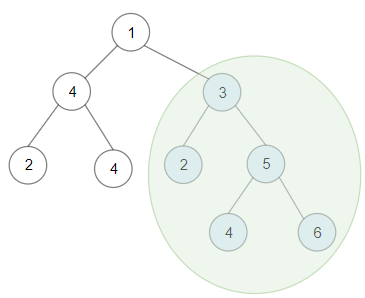Given a binary tree root, the task is to return the maximum sum of all keys of any sub-tree which is also a Binary Search Tree (BST).
Assume a BST is defined as follows:
Example 1:

Input: root = [1,4,3,2,4,2,5,null,null,null,null,null,null,4,6] Output: 20 Explanation: Maximum sum in a valid Binary search tree is obtained in root node with key equal to 3.
Example 2:

Input: root = [4,3,null,1,2] Output: 2 Explanation: Maximum sum in a valid Binary search tree is obtained in a single root node with key equal to 2.
Example 3:
Input: root = [-4,-2,-5] Output: 0 Explanation: All values are negatives. Return an empty BST.
Example 4:
Input: root = [2,1,3] Output: 6
Example 5:
Input: root = [5,4,8,3,null,6,3] Output: 7
Constraints:
40000 nodes..[-4 * 10^4 , 4 * 10^4].The core challenge of this problem is to identify the largest sum of keys in any subtree that is a valid Binary Search Tree (BST). A BST is defined by the properties that all nodes in the left subtree are less than the root, and all nodes in the right subtree are greater than the root. Both subtrees must also be BSTs.
This problem is significant in various applications such as database indexing, where BST properties are used to maintain sorted data for efficient retrieval.
Potential pitfalls include incorrectly identifying BSTs or not considering all possible subtrees.
To solve this problem, we can use a recursive approach to traverse the tree and check for BST properties. A naive solution would involve checking every possible subtree, which is inefficient. Instead, we can use a post-order traversal to gather information about each subtree and determine if it forms a BST.
We will use a helper function that returns multiple values: whether the subtree is a BST, the sum of the subtree, the minimum value in the subtree, and the maximum value in the subtree. This information allows us to efficiently determine if a larger subtree is a BST and calculate its sum.
The algorithm involves a post-order traversal of the tree. For each node, we recursively check its left and right subtrees. We then use the information from these subtrees to determine if the current subtree is a BST and calculate its sum if it is.
Here is a step-by-step breakdown:
#include <iostream>
#include <tuple>
#include <algorithm>
#include <climits>
using namespace std;
// Definition for a binary tree node.
struct TreeNode {
int val;
TreeNode *left;
TreeNode *right;
TreeNode() : val(0), left(nullptr), right(nullptr) {}
TreeNode(int x) : val(x), left(nullptr), right(nullptr) {}
TreeNode(int x, TreeNode *left, TreeNode *right) : val(x), left(left), right(right) {}
};
class Solution {
public:
int maxSumBST(TreeNode* root) {
int maxSum = 0;
postOrderTraversal(root, maxSum);
return maxSum;
}
private:
// Helper function to perform post-order traversal and check BST properties
tuple postOrderTraversal(TreeNode* node, int& maxSum) {
if (!node) {
return {true, 0, INT_MAX, INT_MIN}; // Base case: empty subtree
}
auto [leftIsBST, leftSum, leftMin, leftMax] = postOrderTraversal(node->left, maxSum);
auto [rightIsBST, rightSum, rightMin, rightMax] = postOrderTraversal(node->right, maxSum);
if (leftIsBST && rightIsBST && node->val > leftMax && node->val < rightMin) {
int currentSum = node->val + leftSum + rightSum;
maxSum = max(maxSum, currentSum);
int currentMin = min(node->val, leftMin);
int currentMax = max(node->val, rightMax);
return {true, currentSum, currentMin, currentMax};
} else {
return {false, 0, 0, 0}; // Not a BST
}
}
};
int main() {
// Example usage:
TreeNode* root = new TreeNode(1);
root->left = new TreeNode(4);
root->right = new TreeNode(3);
root->left->left = new TreeNode(2);
root->left->right = new TreeNode(4);
root->right->left = new TreeNode(2);
root->right->right = new TreeNode(5);
root->right->right->left = new TreeNode(4);
root->right->right->right = new TreeNode(6);
Solution sol;
cout << "Maximum Sum BST: " << sol.maxSumBST(root) << endl;
return 0;
}
The time complexity of this approach is O(n), where n is the number of nodes in the tree. This is because we visit each node exactly once during the post-order traversal.
The space complexity is O(h), where h is the height of the tree. This is due to the recursive call stack, which can go as deep as the height of the tree.
Potential edge cases include:
These cases are handled by the base case in the helper function and the conditions checking for BST properties.
To test the solution comprehensively, consider the following test cases:
Using a testing framework like Google Test can help automate and manage these test cases effectively.
When approaching such problems, consider the following tips:
In this blog post, we discussed how to solve the problem of finding the maximum sum BST in a binary tree using a recursive approach. We covered the problem definition, approach, algorithm, code implementation, complexity analysis, edge cases, and testing. Understanding and solving such problems is crucial for improving problem-solving skills and preparing for technical interviews.
For further reading and practice, consider the following resources:
Our interactive tutorials and AI-assisted learning will help you master problem-solving skills and teach you the algorithms to know for coding interviews.
Start Coding for FREE